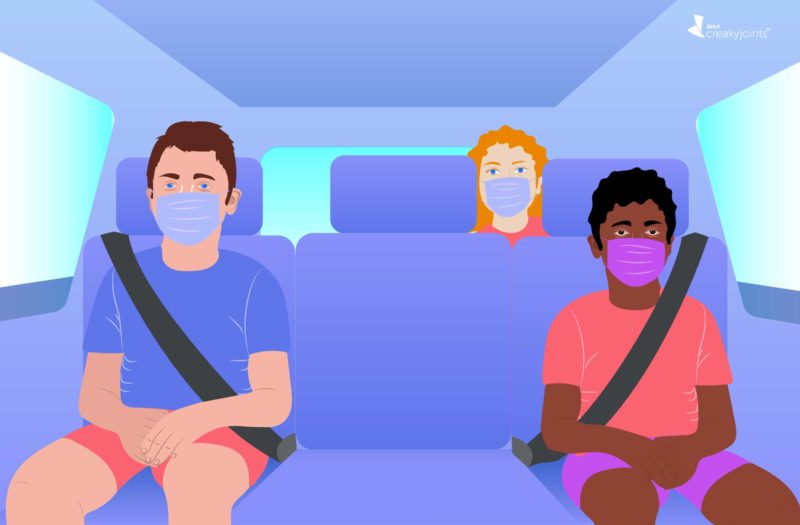As a parent, we bet your number one concern is maintaining the safety of your children. With the onset of COVID-19, this concern has undoubtedly increased for parents all around the world.
Final plans for the 2020-2021 school year still remains under careful consideration by schools and school districts nationwide. Despite this, it is important for parents to prepare for the possibility that campuses will reopen. When students return for in-person instruction, their school days will look much different as the CDC and other safety measures are strictly implemented.
It is important for parents to assess all the transportation options available for their students. Walking, biking, or even skating to school are all valuable because it can be great exercise and easier to maintain social distance from others. Moreover, being in an open space reduces exposure to respiratory droplets unlike when congregating with individuals. For parents who decide driving their children to school is the best option, things will be very different. There will likely be limited access to campus spaces making drop off and pickup a little challenging as some parents maybe used to entering the school. CarpooltoSchool offers schools and their parents web and mobile apps to organize carpools, walkpools and bikepools. The platform leverages technology and supports social distancing while getting students to and from school. Parents may also be able to select schools for their children because CarpooltoSchool options are available.
When transporting children, trust is the real currency exchange. School buses can decrease parents’ confidence in other families to communicate the symptoms and exposures that their own children experience. Short of a daily check-in that parents receive for each trip, trust can be weakened. Creating Carpooling Pods can build stronger school communities that increase the desire to notify parents of symptoms or family exposures. Carpooling Pods are traveling with the same families who agree to maintain agreed upon safety and exposure measures.
Carpooling Pods
Even though COVID-19 places a lot of uncertainty on livelihoods families, carpooling can offer parents a greater sense of security. First of all, carpooling helps minimize the concerns that accompany conventional school bus routes (see more on this in our previous post). Besides experiencing a scarcer driver availability, school buses allow for a higher number of students to occupy a closed space on their way to and from school. Also, not all school districts have bus monitors to monitor their safety. Contact tracing becomes more difficult should a student test positive for the virus. Not to mention, carpooling gives parents control over vehicle sanitation and ensuring any extra precautions needed for their children.

A Big Win – Parents Helping Each Other Get Back into Life
One big win is helping parents get back to work. By sharing transportation and reducing exposure, parents can feel more confidence to commit to return back to work. Families can coordinate their carpooling schedules to meet the needs of all the parties involved. Using apps, parents can communicate to quickly adapt their plan and avoid sacrificing their work schedules. School bus routes will be less flexible to these real time changes.
Recommendations for Carpooling Pods
With all the benefits to carpooling in these unprecedented times, comes strategic planning by parents to maximize the safety of their carpools. Here are some recommendations for how to do this:

- Limit the number of students in the carpool. By decreasing the number of individuals in a shared space, and utilizing assigned seating, you can increase the distance between passengers. This helps avoid close respiratory contact. Doing this also helps limit the number of individuals your child comes in close contact with during their school day.
- Require everyone to wear adequate masks. Masks are an effective tool stressed by the Center for Disease Control and Prevention (CDC) to limit the spread of respiratory droplets. Not only will this also be a requirement for students on campus, but it also adds an extra layer of protection should one of the passengers be asymptomatic.
- Maintain vehicle air flow. A report conducted by the European Centre for Disease Control and Prevention concluded that allowing for adequate airflow in vehicles, such as non-recirculated air systems or open windows, can help decrease the transmission of COVID.
- Have hand sanitizer readily available in the car and backpacks. Recommended by the CDC, hand sanitizer helps ensure that germs picked up by the hands passengers do not spread within the vehicle for others to come in contact.
- Disinfect your vehicle. Keeping one’s vehicle disinfected further helps prevent any germs that managed to enter from remaining and coming in contact with another individual. Kevin Hunt of Hartford Healthcare offers recommendations for doing this.
- Utilize “Carpool Pods.” Kelsey Kloss writes for the Global Health Living Foundation that maintaining the same individuals in your carpool helps limit your social circle. This lowers the number of indirect contacts you and your children may have with an infected individual.
- Maintain open communication between carpool families. Making sure each family knows what symptoms to look for and building a trust to share them is a crucial way to avoid the spread of the virus. Though this may feel awkward in practice, remember that it helps keep others and yourself safe. Khang T, Vuong, MHA offers tips for how you can best approach this conversation.
Tell Us Your Thoughts
Are you a parent thinking about how your children will return to school? We’d love to hear your thoughts and concerns! Please take our anonymous survey:




